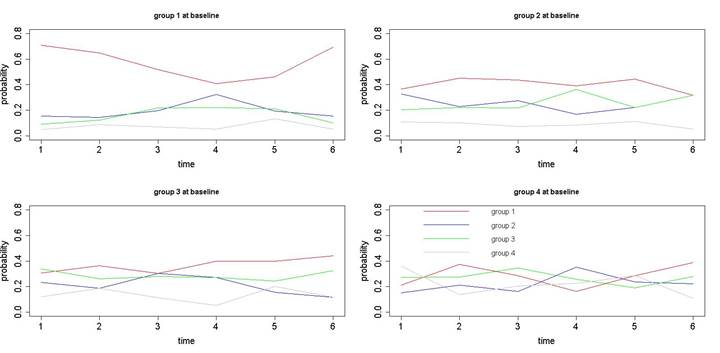Session Information
Date: Tuesday, November 10, 2015
Title: Systemic Lupus Erythematosus - Clinical Aspects and Treatment Poster Session III
Session Type: ACR Poster Session C
Session Time: 9:00AM-11:00AM
Background/Purpose:
Treatment of
systemic lupus erythematosus (SLE) aims at controlling disease activity to
prevent damage. In a large multi-centre cohort of prevalent SLE patients we previously
described a high proportion of patients with active disease and requiring
steroid treatment. We examined changes in disease activity over time in this
cohort.
Methods:
Predictors of
changes in disease activity over the follow-up period, including symptoms,
sociodemographic characteristics, and treatment were described in our cohort. Four
groups were created based on their SLEDAI score at cohort entry (T0): 1: no or low
(<4); 2: moderate (4 to <6); 3: active (6 to <10) and 4: highly active
(≥10). Linear and mixed regression models) were used to identify
predictors of changes in SLEDAI over time.
Results:
Among 2,048
participants, 1314, 553, 271, 183 and 146 had follow-up data at 1, 2, 3, 4 and
5 years, respectively. At T0, for all patients, mean (sd) age was 42 years (17), age at
diagnosis was 31 (15), disease duration 11 (10) years. There were 90% females, 84
% had completed high school, and 63% were Caucasians. At T0, almost half of
the patients were in Group 1 (n=898, 44%; 95%CI: 42-46%), 1/5 were in Group 2 (n=406,
20%; 95%CI: 18-22%) or Group 3 (n=447, 22%; 95%CI: 20-24%), while 287 (14%; 95%CI:
13-16%) were in Group 4. The probability that patients in Group 1 at T0 would
move to a higher disease activity level was 30% at 1 year, 36% at 2 years, 49%
at 3 years, 59% at 4 years and 54% at 5 years; transitions shown in Figure 1. In
linear regression of changes in the 1st year, higher SLEDAI at T0
was a very significant predictor of higher SLEDAI at year 1 (0.3 unit increase
for each additional SLEDAI unit at T0; p<0.00001). Higher Income was
associated with lower SLEDAI at Yr 1 (0.5 unit decrease per each higher of 5 income
categories, p=0.002), but there were no demographic or clinical predictors of
disease activity changes. In
mixed model analyses of i. longitudinal data across follow-up, and ii. if/how
variables at previous visits predict changes in SLEDAI scores at the next visit,
higher T0 SLEDAI was the single significant predictor of higher SLEDAI across
the follow-up (1 unit increase in Yr 0 is associated with 0.3 increase in Yr1,
p=0.001; and 0.3 increase per 1 unit increase at previous visit, p<0.0001),
again without significant demographic or clinical predictors of disease
activity changes.
Conclusion:
In our analyses
more than 1/2 the patients had active disease at T0, and 116 (64.1%) of 181
patients with moderate to high disease activity at T0, who had at least 3 years
of follow-up remained in this category for at least 3 years. Higher SLEDAI was
the single major independent predictor of higher SLEDAI over time. Our data
support persistence of active disease over the disease course in a significant
subset of patients, even in those with longstanding disease. This highlights
gaps in the optimal treatment of lupus and the need for additional therapies.
To cite this abstract in AMA style:
Peschken CA, Wynant W, Abrahamowicz M, Pope JE, Silverman E, Sayani A, Iczkovitz S, Ross JA, Pineau C, Smith CD, Hudson M, Zummer M, Tucker LB, Levy DM, Chédeville G, Huber AM, Arbillaga H, Hitchon C, Fortin PR. Persistent Disease Activity over Time in a Large Canadian Cohort of Prevalent Lupus Patients [abstract]. Arthritis Rheumatol. 2015; 67 (suppl 10). https://acrabstracts.org/abstract/persistent-disease-activity-over-time-in-a-large-canadian-cohort-of-prevalent-lupus-patients/. Accessed .« Back to 2015 ACR/ARHP Annual Meeting
ACR Meeting Abstracts - https://acrabstracts.org/abstract/persistent-disease-activity-over-time-in-a-large-canadian-cohort-of-prevalent-lupus-patients/

